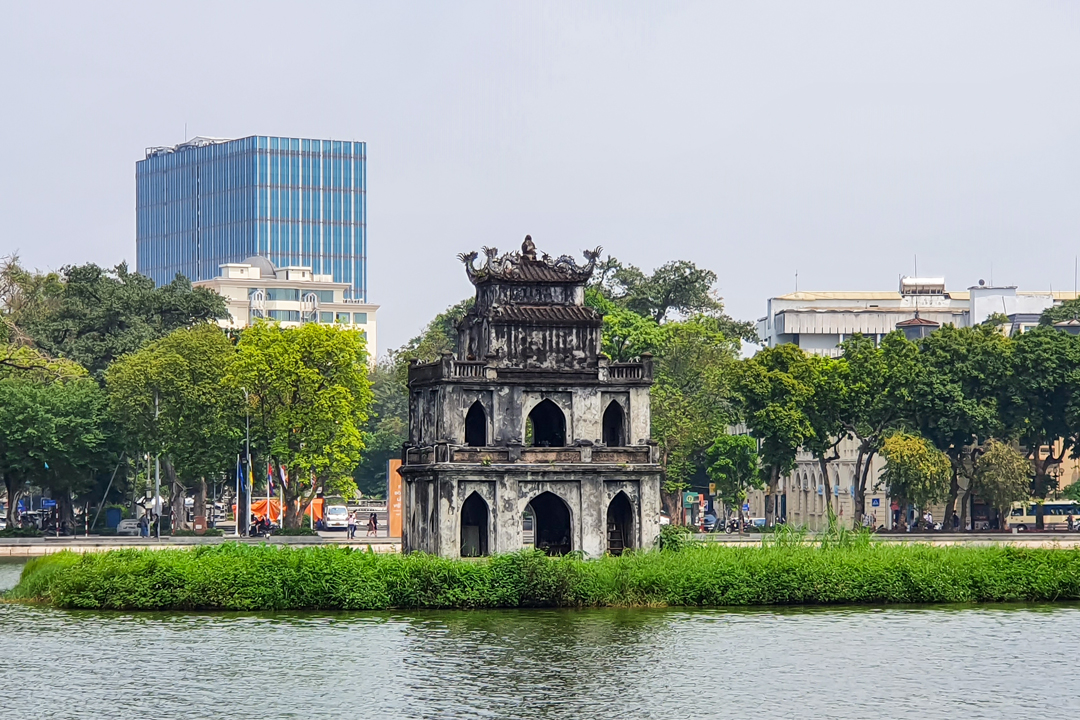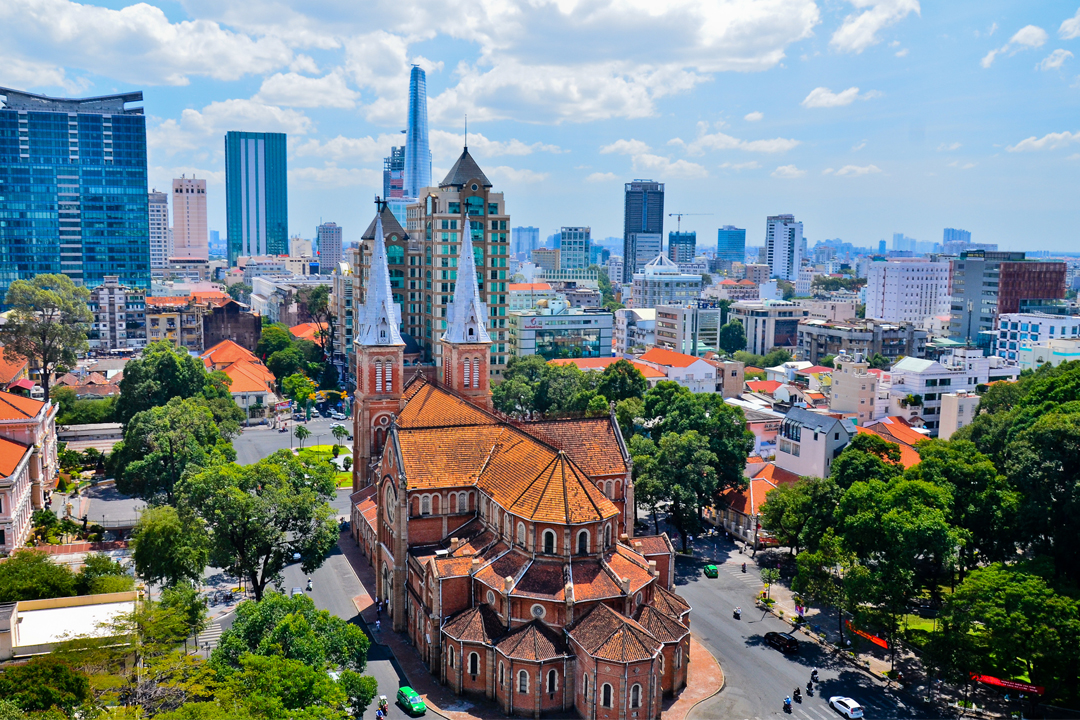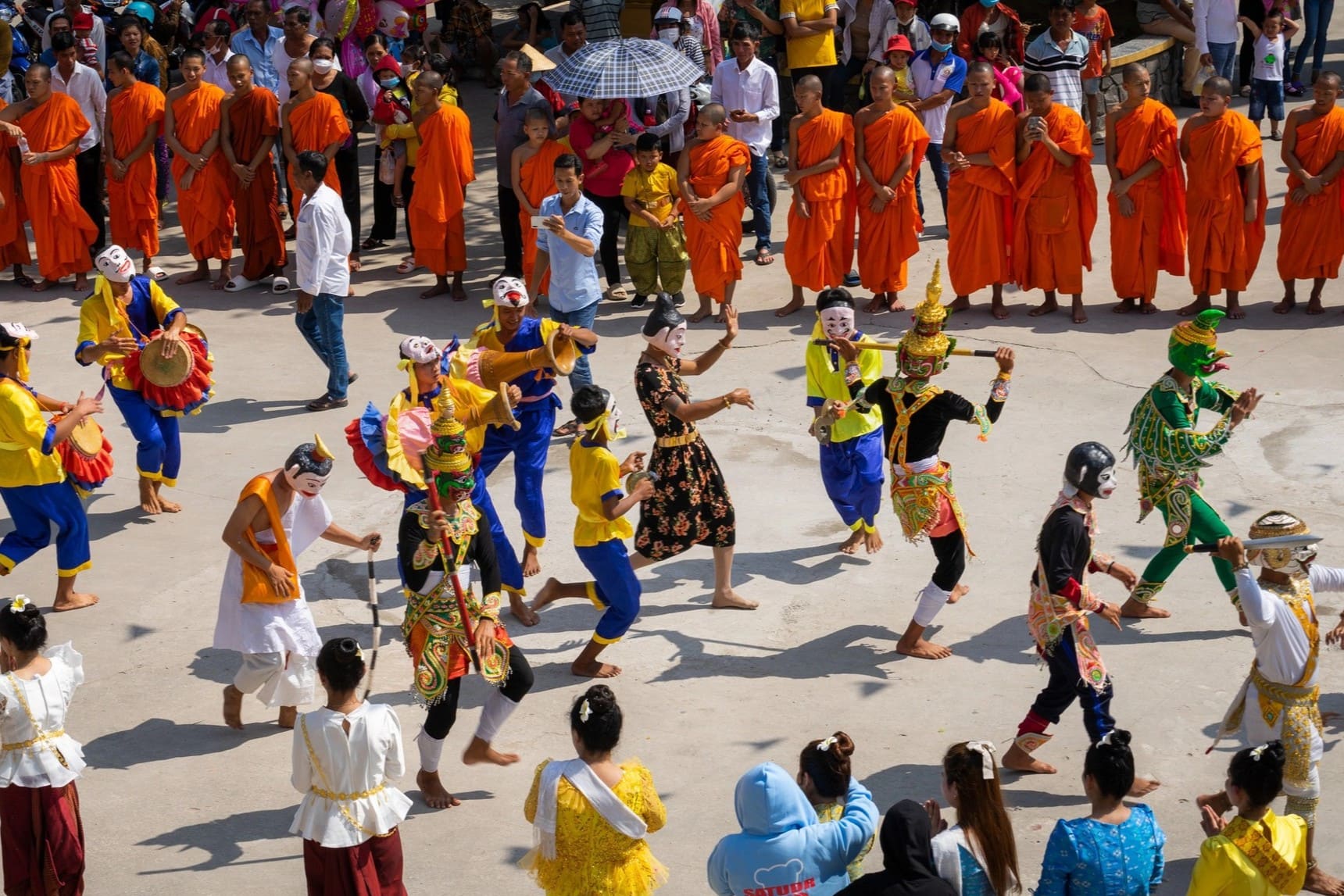Japanese Covered Bridge (Bridge Pagoda): History, Architecture & Travel Guide
Tucked within the heart of Hoi An Ancient Town, the Japanese Covered Bridge (Bridge Pagoda) is a powerful symbol of cultural harmony and historical depth. This centuries-old bridge, linking two sides of the old town, reflects the deep-rooted ties between Japanese merchants and the local Vietnamese community. Framed by the charm of a UNESCO World Heritage site, the bridge captivates with its unique blend of architectural styles. Its stone guardians, a monkey and a dog, add an intriguing touch to its timeless appeal.
In this GTrip’s guide, we go beyond surface-level sightseeing to uncover the rich stories behind this architectural gem. From its layered past to the meticulous efforts to preserve it for future generations, the Japanese Covered Bridge offers more than a photo opportunity. It invites travelers, history lovers, and design enthusiasts to step into a living narrative shaped by centuries of cultural exchange.
The history of the Japanese Covered Bridge
The Japanese Covered Bridge, known locally as Chua Cau, is located at the west end of Tran Phu Street in Hoi An. It holds a unique place in both the architectural and cultural history of Hoi An Ancient Town.
The historical origins of the Japanese Covered Bridge
The Japanese Covered Bridge, constructed in the late 16th or early 17th century, is believed to have been built by the Japanese community living in Hoi An. This took place during a time when the town thrived as a bustling international trading port. This era saw Hoi An become a melting pot of cultures due to trade relations between Vietnam, Japan, China, and even Europe. The bridge physically and symbolically connected the Japanese quarter with the Chinese quarter, serving as a pedestrian passage and also as a cultural and diplomatic landmark.
The Japanese, renowned for their deep respect for nature and expertise in woodworking and architectural design, aimed to build a structure that was both practical and symbolic of their cultural heritage. This led to the creation of a covered wooden bridge that also housed a small temple, reflecting the spiritual ethos of Japanese architecture at the time.
Significance in trade and cultural exchange
During the 17th century, Hoi An was one of Southeast Asia's most significant trading ports. The bridge facilitated trade and cultural exchange among the diverse communities that inhabited the town. It served as a critical link across Hoi An's canal systems, joining the varied cultural districts while promoting interactions and mutual exchange of traditions and practices.
The bridge's existence is a testament to the Japanese community's influence and harmony with local Vietnamese customs, as its structure combines Japanese craftsmanship with local architectural techniques. This fusion symbolizes the spirit of collaboration and mutual respect prevalent among the immigrant communities and local inhabitants during Hoi An's peak trading years.
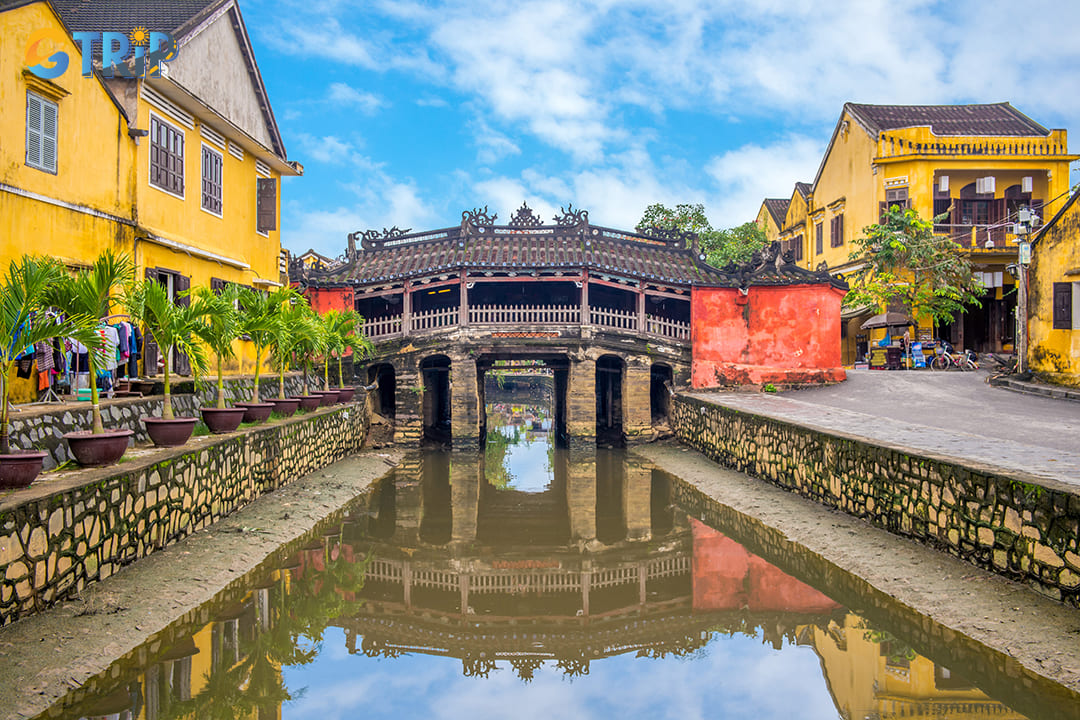
The bridge's existence is a testament to the Japanese community's influence and harmony with local Vietnamese customs
Cultural symbolism and influence
Embedded within the design of the Japanese Covered Bridge are significant cultural symbols that speak volumes about its historical importance. The bridge is adorned with a small temple dedicated to Bac De Tran Vo, a revered deity in Vietnamese culture, reflecting the integration of local religious practices. This inclusion demonstrates the intermingling of spiritual beliefs between the Japanese immigrants and the local Vietnamese populace.
Statues of a monkey and a dog stand at the two ends of the bridge. These figures are widely believed to represent the years when the bridge's construction began and ended. This timeframe aligns with the early Edo period in Japan, a time marked by relative peace and national isolation. These animal guardians possess protective symbolism, serving as spiritual wardens for those crossing the bridge.
The bridge is a national and UNESCO Heritage Site
Today, the Japanese Covered Bridge is not only a beloved cultural emblem of Hoi An but also a recognized National Historical and Cultural Relic of Vietnam. It forms an integral part of the Hoi An Ancient Town, a UNESCO World Heritage Site, which reflects its global importance. UNESCO's recognition underscores the bridge's value in understanding the broader historical narrative of international maritime trade and cultural synthesis in Asia.
The structure's enduring presence amidst modern development challenges highlights its significance as a tangible connection to an illustrious past. As restoration projects proceed to ensure its longevity, maintaining the bridge's authenticity remains vital to preserving the rich history and cultural heritage it represents. The image of the Japanese Covered Bridge is also printed on the back of the VND 20,000 banknote.
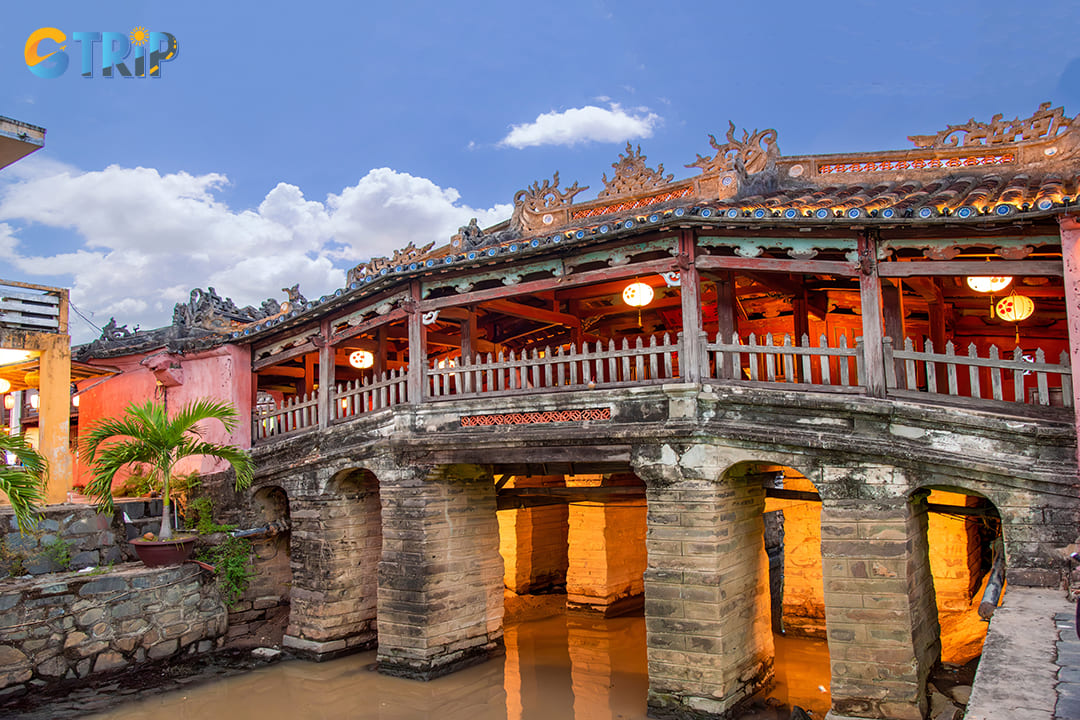
Today, the Japanese Covered Bridge is not only a beloved cultural emblem of Hoi An but also a recognized National Historical and Cultural Relic of Vietnam
Architecture of the Japanese Covered Bridge
The architecture of the Japanese Covered Bridge is a harmonious blend of Japanese, Vietnamese, and Chinese influences. This showcases intricate wooden craftsmanship and symbolic design elements.
The fusion of Japanese and Vietnamese architectural styles
The Japanese Covered Bridge in Hoi An, known locally as Chua Cau, is a remarkable embodiment of cultural synthesis. This bridge represents a harmonious blend of Japanese architecture and Vietnamese cultural elements, a reflection of the historical interactions between the two regions. Constructed by the Japanese community in the early 17th century, the bridge’s structure is distinctively Japanese, mirroring the architectural style of Nihonbashi in Edo, now Tokyo. Its roofline, however, exhibits traditional Vietnamese pagoda influences, complete with intricate carvings and an ornate tiled roof, illustrating the adaptation to local aesthetics and spiritual norms.
This architectural fusion is most apparent when observing the timbered structure juxtaposed against the decorative elements. T0. The bridge serves as a physical manifestation of the historical trade and cultural exchanges that occurred during Hoi An's period as a bustling international port.
Key structural and aesthetic details
The Japanese Covered Bridge, a national historical relic, showcases several critical structural and aesthetic details. The bridge is approximately 18 meters long, creating a modest yet significant passageway over a small canal that connects to the Thu Bon River. Its wooden framework is crafted from durable, locally sourced timber. This showcases the Japanese expertise in wooden construction. It also reflects their adaptation to Vietnam’s tropical climate, which demands materials that can endure high humidity and occasional flooding.
Two notable features of the bridge are the statues of animals stationed at either end. The monkey and dog statues are not merely decorative. They carry symbolic significance, believed to represent the years during which the bridge's construction commenced and concluded. These animals echo traditional East Asian zodiac symbols, which are integral to both Japanese and Vietnamese cultures.
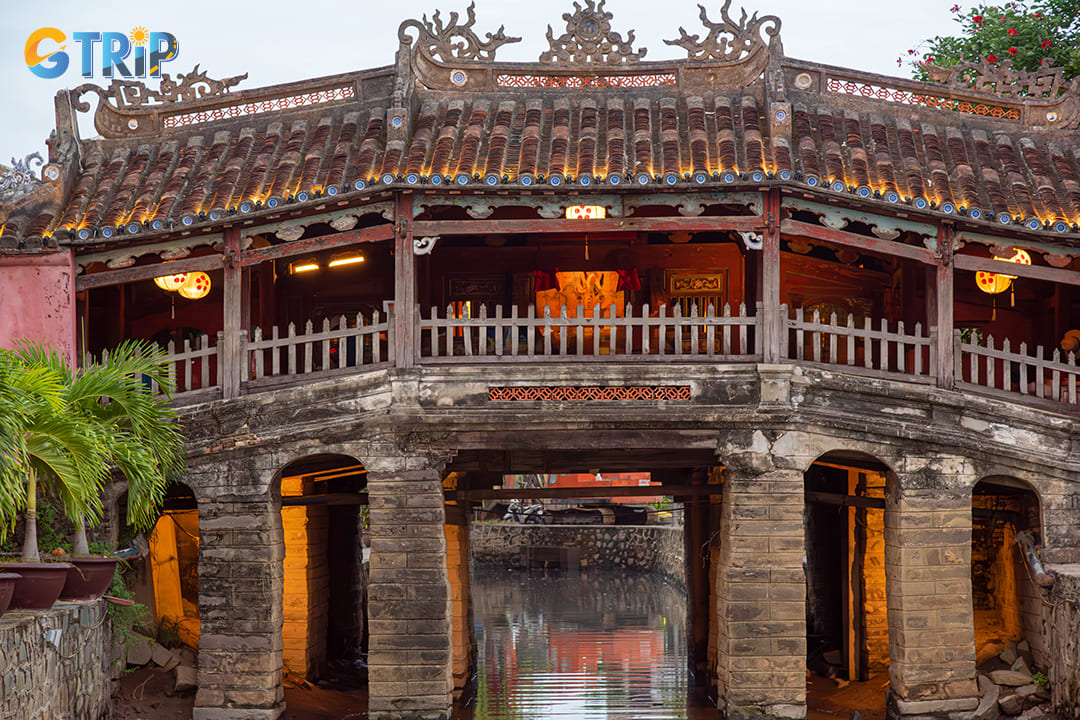
The bridge represents a harmonious blend of Japanese architecture and Vietnamese cultural elements, a reflection of the historical interactions between the two regions
Inside the covered bridge lies an internal shrine dedicated to Bac De Tran Vu, a revered deity believed to safeguard the land against floods and natural calamities. This sacred space underscores the bridge’s dual role as both a physical connector and a spiritual haven. Additionally, the bridge's roof is notable for its ornate tiles and dragon motifs, elements commonly found in Vietnamese religious architecture. These decorative features serve both practical and aesthetic purposes. The tiled roof offers protection against the elements while the dragons, revered creatures in both cultures, symbolize strength and protection.
In light of these architectural and design elements, the Japanese Covered Bridge stands as a testament to the rich tapestry of cultural heritage that defines Hoi An. Its unique blend of styles, structural integrity, and spiritual elements combine to create a landmark that is both historically significant and aesthetically compelling. Such features ensure that Chua Cau remains a focal point not just for historical admiration but as a living monument of cultural synthesis and architectural ingenuity.
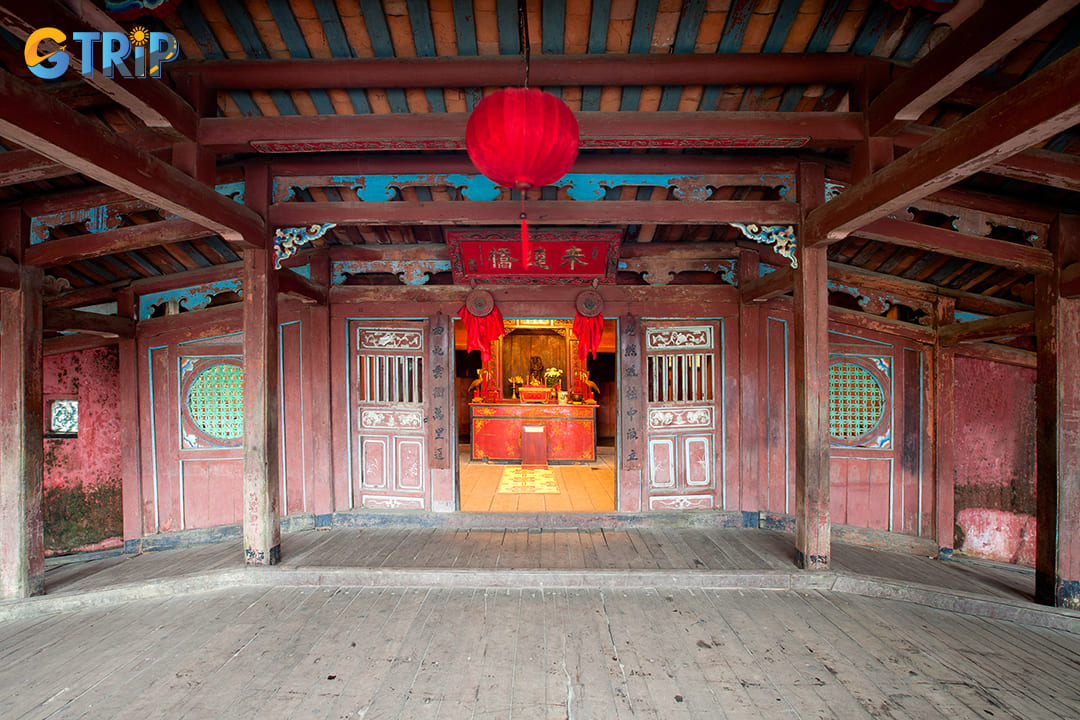
Inside the covered bridge lies an internal shrine dedicated to Bac De Tran Vu, a revered deity believed to safeguard the land against floods and natural calamities
5 things to do when visiting the Japanese Covered Bridge
The Japanese Covered Bridge, also known as Chua Cau, is one of Vietnam's most iconic historical landmarks. Here are the top things to do when you visit this architectural gem.
1. Admire the intricate architecture and symbolism
The Japanese Covered Bridge is renowned for its unique architectural blend of Japanese, Chinese, and Vietnamese styles. Built entirely from wood and stone, the bridge features a gently arched walkway sheltered by a tiled roof, which was added to protect it from the elements. Two stone statues, the dog and the monkey, stand guard at either end of the bridge. These animals are not just decorative; they represent the years many believe the construction began and ended, based on the Japanese zodiac. Inside the bridge, you’ll also find a small temple dedicated to Bac De Tran Vu, the Taoist god of weather, who was believed to protect the town from natural disasters. Every element of the bridge, from its hand-carved beams to its symbolic motifs, reflects the spiritual and cultural values of Hoi An’s early settlers.
2. Capture stunning photographs
Photography lovers will find no shortage of captivating angles at the Japanese Covered Bridge. During the day, its weathered timbers and serene canal setting make for a timeless, rustic image. At night, the bridge takes on a magical glow as traditional lanterns illuminate both the structure and the water below, offering a dramatic contrast and atmosphere. For the best composition, try framing the bridge from across the canal or from the slight elevation at either end, capturing its reflection in the water. Macro shots of the intricate woodwork or the faded yet colorful decorative panels also make for excellent travel detail shots. For those seeking lifestyle images, you’ll often spot locals in ao dai walking near the bridge, perfect for adding a cultural touch to your photos.
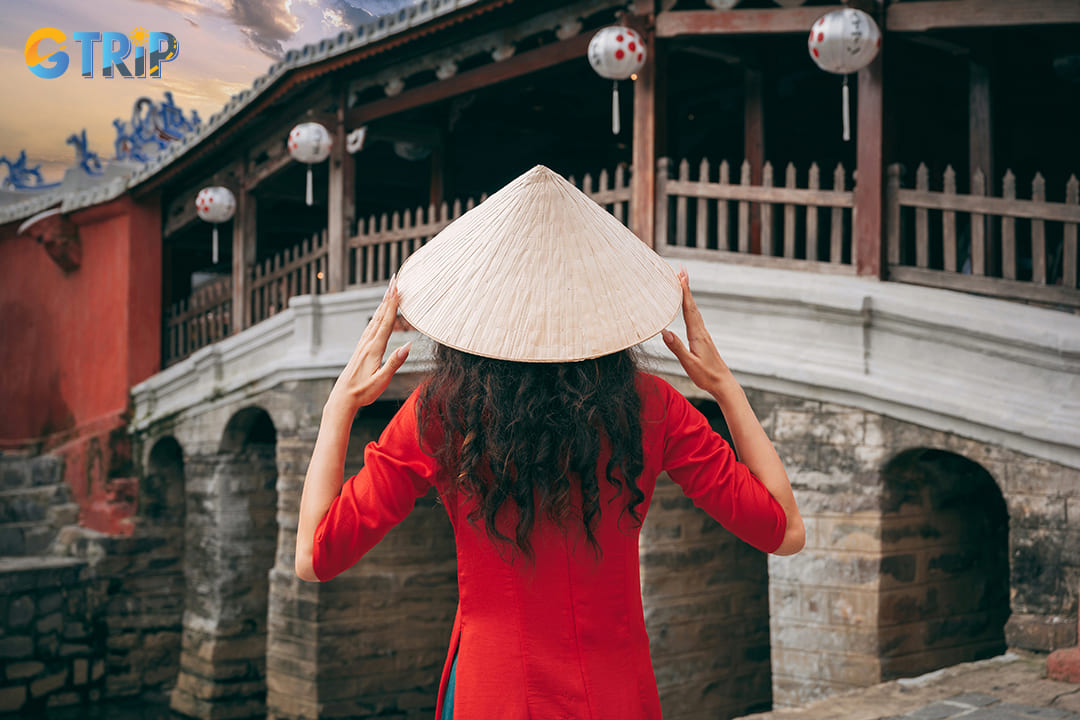
During the day, the bridge’s weathered timbers and serene canal setting make for a timeless, rustic image
3. Visit the nearby old quarter
The Japanese Covered Bridge is seamlessly integrated into Hoi An’s UNESCO-listed Old Quarter, making it the perfect starting point for a walking tour. Just steps from the bridge, you’ll find cobbled streets lined with mustard-yellow colonial buildings, charming wooden shop-houses, and vibrant lanterns swaying overhead. Dive into the local culinary scene by trying cao lau, a noodle dish unique to Hoi An, or grab a delicious banh mi from a street vendor. Many of the nearby buildings are home to tailors offering custom-made clothing or artisans crafting silk lanterns, leather goods, and bamboo souvenirs. Don’t miss the chance to visit nearby landmarks like the Tan Ky Ancient House or the Phuc Kien Assembly Hall, both within easy walking distance. A leisurely stroll through the Old Quarter is an immersion into centuries of preserved history and culture.
4. Shop for art and handicrafts around the bridge
Just a short walk from the bridge, you'll find a collection of boutique shops, art galleries, and craft stores that reflect Hoi An’s creative soul. This area is ideal for purchasing traditional Vietnamese silk lanterns, hand-painted ceramics, and woodblock prints inspired by ancient Vietnamese folklore. Some shops even allow you to watch artisans at work - painting, carving, or assembling intricate crafts using techniques passed down through generations. Many of these items are unique to Hoi An and make for meaningful, authentic souvenirs. Supporting these local craftspeople brings home a piece of the town’s culture and also contributes to its preservation.
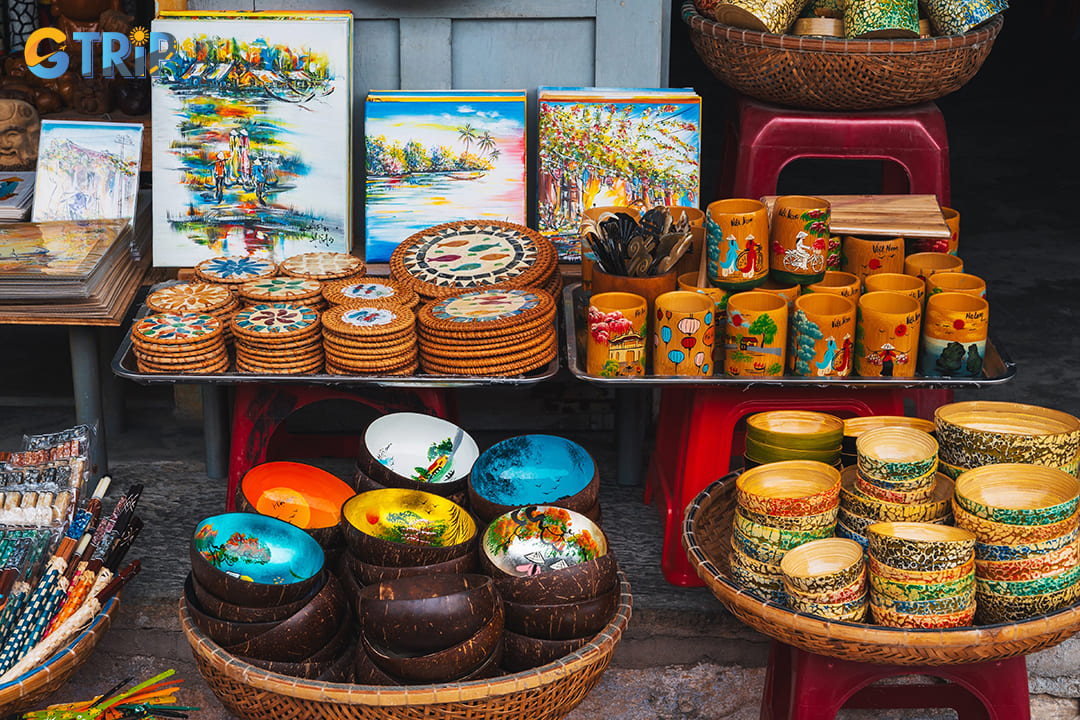
Just a short walk from the bridge, you'll find a collection of boutique shops, art galleries, and craft stores that reflect Hoi An’s creative soul
5. Participate in lantern festivals for the night tour
Joining a lantern festival is one of the most magical ways to experience the Japanese Covered Bridge at night. The most famous event is the Hoi An Full Moon Lantern Festival, held on the 14th day of every lunar month. During this celebration, the area around the bridge transforms into a glowing riverside wonder. Locals and tourists release colorful paper lanterns onto the water to make wishes for peace, health, and good fortune. The canal shimmers with hundreds of floating lights, creating an enchanting and serene atmosphere. Throughout the night, the streets come alive with bai choi folk singing, traditional dances, and cultural games that offer a glimpse into Vietnam’s rich heritage. Even if you miss the festival date, lantern-lit evenings around the bridge are still common, accompanied by live music, storytelling, and the gentle glow that makes Hoi An's nights unforgettable.

Joining a lantern festival is one of the most magical ways to experience the Japanese Covered Bridge at night
Ticket prices
The Japanese Covered Bridge is part of the Hoi An Ancient Town ticket system.
- Vietnamese visitors: 80,000 VND per person per visit
- International visitors: 120,000 VND per person per visit
- Children under 1 meter: Free of charge
- Children from 1 meter to 1.4 meters: Reduced ticket price (around 40,000 - 50,000 VND, depending on nationality)
This ticket grants access to the Ancient Town area and allows you to choose 3 out of 21 designated attractions, including the Japanese Covered Bridge.
Free access areas: The Japanese Covered Bridge is also located in a zone that is accessible without a ticket, meaning you can freely view and take photos of the exterior without paying. However, to explore the interior and other ticketed heritage sites, you’ll need to purchase the Ancient Town ticket.
Ideal photography tips and best times to visit
For photography enthusiasts, capturing the Japanese Covered Bridge in Hoi An requires careful timing and technique to showcase its architectural beauty. Here are some specific tips and optimal times for photographing this iconic landmark:
Best times for photography
- Golden hour (Sunrise and sunset):
- Sunrise: Around 5:30 AM to 6:30 AM
- Sunset: Approximately 5:30 PM to 6:30 PM. These times offer soft, warm lighting that enhances the bridge's features and creates beautiful reflections on the water.
- Blue hour: Evening: About 30 minutes after sunset (around 6:30 PM to 7:00 PM). This period provides a striking contrast between the illuminated bridge and the deep blue sky.
- Night photography: From 7:00 PM onwards, the bridge is beautifully illuminated at night, allowing for dramatic long-exposure shots.
Photography tips
- Use a tripod: Essential for low-light and long-exposure shots, especially during blue hour and nighttime.
- Wide-angle lens: Capture the entire bridge and its surroundings, ideally from the viewpoint of another nearby bridge.
- Composition techniques:
- Shoot from a low angle near the water to capture reflections.
- Include surrounding elements like lanterns and traditional buildings for context.
- Avoid crowds: Visit early morning (before 9:00 AM) or late evening (after 8:00 PM) to minimize the number of people in your shots.
- Long exposure: Use this technique at night to capture light trails and smooth water surfaces.
- Weather considerations: Overcast days can provide soft, even lighting, ideal for detailed architectural shots.
Remember to be respectful of local customs and obtain any necessary permissions when photographing in and around the bridge. The bridge is open 24 hours, but the best photographic opportunities often align with the quieter periods early in the morning or later in the evening.

For photography enthusiasts, capturing the Japanese Covered Bridge in Hoi An requires careful timing and technique to showcase its architectural beauty
Transportation to Hoi An and the Japanese Covered Bridge
To get to Hoi An and visit the Japanese Covered Bridge, you have many transportation options from different locations in Vietnam that are often recommended by Hoi An tour providers. Here are the details with prices:
From Da Nang to Hoi An
- Taxi/Grab:
- Cost: Approximately 350,000 to 430,000 VND (14.90 to 18.31 USD) per trip.
- Duration: About 40 minutes.
- Pros: Convenient and quick, suitable for those with luggage.
- Hop-on hop-off bus:
- Cost: Around 130,000 VND (5.54 USD) per person.
- Duration: Also about 40 minutes.
- Pros: Economical and comfortable.
From Ho Chi Minh City to Hoi An
- Bus:
- Cost: Ranges from 500,000 to 700,000 VND (21 to 30 USD) for basic buses, and 800,000 to 1,200,000 VND (34 to 52 USD) for VIP buses.
- Duration: Approximately 20 hours.
- Pros: Affordable option for long-distance travel.
- Flight to Da Nang:
- Cost: Airfare varies, typically between 1,250,000 and 2,500,000 VND (52 to 107 USD).
- Duration: Flight is about 1.5 hours, then transfer to Hoi An.
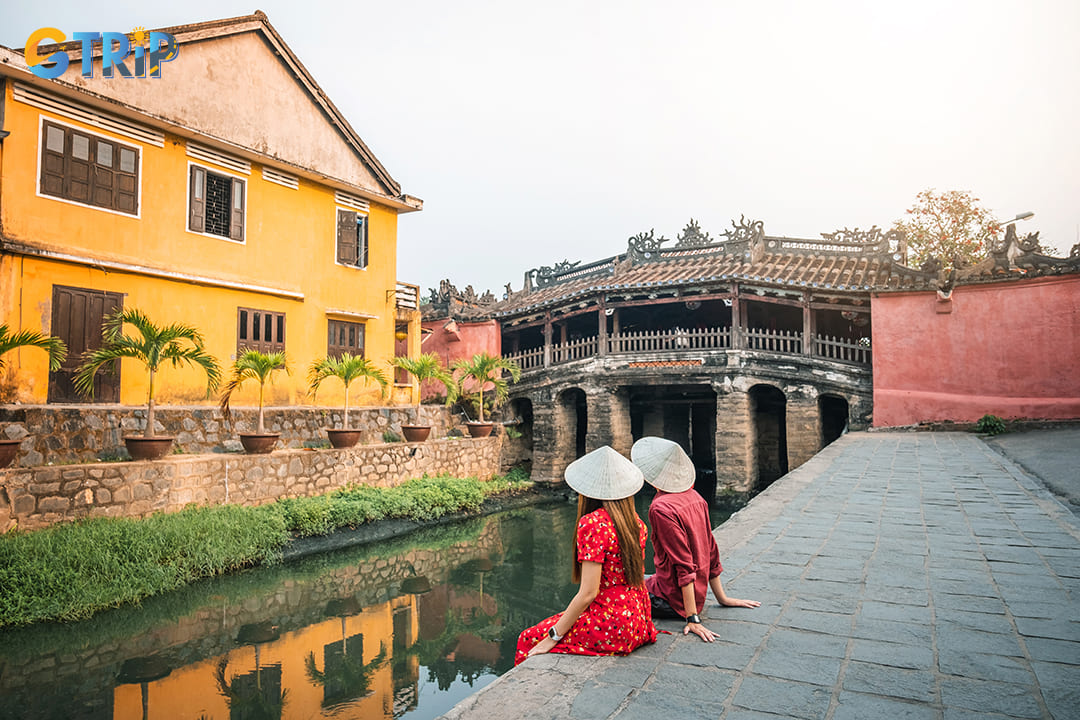
You can reach the Japanese Covered Bridge by many transportation
From Hanoi to Hoi An
- Flight to Da Nang:
- Cost: Flights range from 800,000 to 2,800,000 VND (34 to 120 USD).
- Duration: Flight is about 1.5 hours, then transfer to Hoi An.
- Train:
- Cost: Tickets range from 900,000 to 1,800,000 VND (39 to 77 USD).
- Duration: Approximately 16-20 hours.
- Pros: Scenic route and comfortable sleeper options.
- Sleeper bus:
- Cost: Around 500,000 VND (21 USD).
- Duration: About 20 hours.
- Pros: Economical and convenient for budget travelers.
Local transportation in Hoi An
- Bicycle rental:
- Cost: Approximately 20,000 to 40,000 VND (0.86 to 1.72 USD) per day.
- Pros: Ideal for exploring the ancient town at a leisurely pace.
- Scooter rental:
- Cost: Around 150,000 VND (6.50 USD) per day.
- Pros: Convenient for longer distances and exploring surrounding areas.
- Taxi/Cyclo:
- Cost: Taxis are around 100,000 to 120,000 VND (4.34 to 5.21 USD) for short trips, and cyclos cost about 150,000 VND (6.52 USD) per hour.
- Pros: Easy to find and suitable for short trips within the town.
These options provide flexibility based on your budget and travel style, ensuring a convenient and enjoyable journey to Hoi An and the Japanese Covered Bridge.
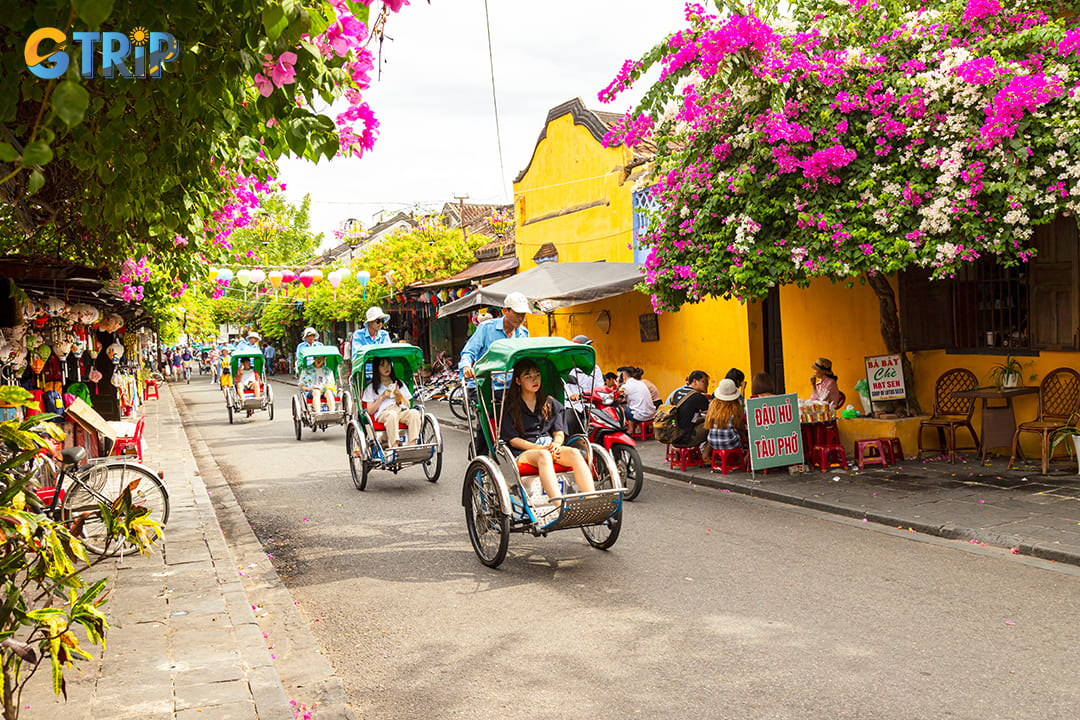
You can try going by cyclo in Hoi An
Nearby attractions from the Japanese Covered Bridge
Hoi An Ancient Town, renowned for its charming historical architecture and cultural richness, offers an array of attractions beyond the iconic Japanese Covered Bridge. As a UNESCO World Heritage Site, the town is a treasure trove of historical landmarks and picturesque spots that are easily accessible on foot. Below, we explore the neighboring attractions that contribute to the town's unique allure.
Fujian Assembly Hall (Phuc Kien Assembly Hall): 500m
Located near the Japanese Covered Bridge, the Fujian Assembly Hall is an illustrious representation of Chinese architectural grandeur. Constructed by the Chinese community in the late 17th century, it served as a meeting place for Chinese immigrants from Fujian. The hall is adorned with intricate woodwork, colorful altars, and a majestic entrance that welcomes tourists into a space filled with historical reverence. The temple within the hall is dedicated to the sea goddess Mazu, reflecting the maritime heritage of Hoi An's trading port history.

The Fujian Assembly Hall is an illustrious representation of Chinese architectural grandeur
Cantonese Assembly Hall (Quang Trieu or Quang Dong Assembly Hall): 50m
A short stroll from the Japanese Covered Bridge, the Cantonese Assembly Hall is another captivating site. Built in 1885, it reflects the rich cultural exchange between the Cantonese community and Hoi An. You can marvel at its dragon statues and elaborately decorated main gate, which exude an aura of ancient Chinese mystique. The hall also hosts a variety of cultural events and exhibitions, providing insights into traditional Cantonese customs.
Tan Ky Old House: 220m
Just a stone's throw from the bridge, the Tan Ky Old House is an epitome of architectural elegance and historical significance. This 200-year-old merchant house has preserved its original design with a seamless blend of Japanese, Chinese, and Vietnamese styles. Exploring its interiors offers a glimpse into the past trading lifestyle, showcasing antique furniture and calligraphy paintings that narrate the house's storied past. It's a testament to the cultural amalgamation that defines Hoi An.
Quan Cong Temple: 550m
Situated nearby, the Quan Cong Temple is dedicated to the Chinese general Quan Cong, known for his loyalty and integrity. The temple, dating back to the mid-17th century, features detailed bronze statues, gilded altars, and elegant courtyards that reflect the artistic brilliance of the era. It serves as a sanctuary for those seeking spiritual solace and an appreciation for religious architecture.
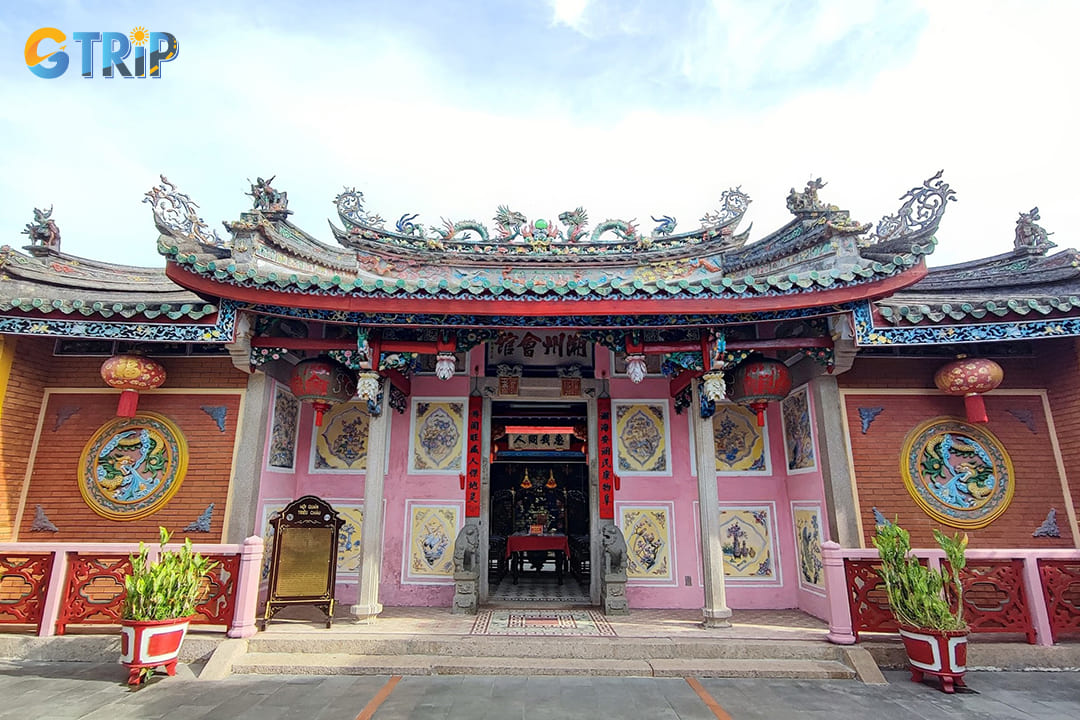
The Quan Cong Temple is dedicated to the Chinese general Quan Cong, known for his loyalty and integrity
FAQs about the Japanese Covered Bridge
- Why is the Japanese Covered Bridge famous?
It is renowned for its historical significance, architectural uniqueness, and as a symbol of the cultural fusion between Japan and Vietnam.
- Is the bridge accessible to tourists currently?
Access is subject to restoration schedules, so checking the latest updates on the Hoi An tourism website is advised.
- What do the dog and monkey statues symbolize?
These statues are believed to symbolize the years marking the bridge’s construction from the year of the Monkey to the year of the Dog. It embodies a blend of mythological symbolism and historical markers.
- Is a ticket required for the visit?
Generally, access is part of the Hoi An Ancient Town entrance ticket, emphasizing the integrated nature of Hoi An as a collective heritage site.
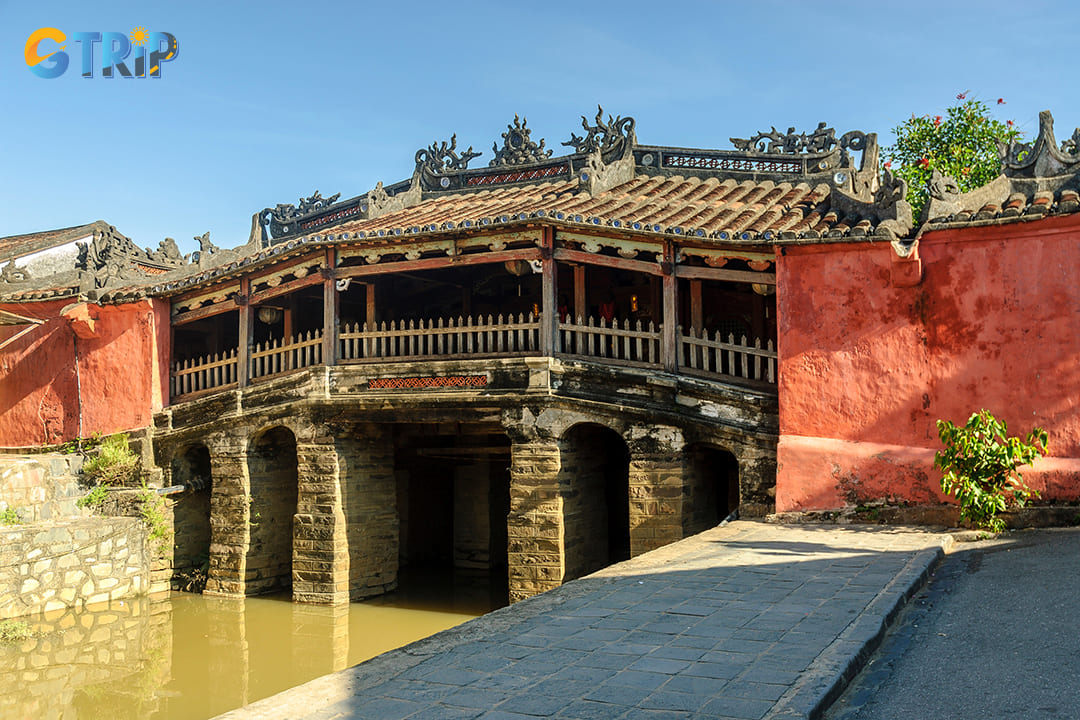
Japanese Covered Bridge is renowned for its historical significance, architectural uniqueness, and as a symbol of the cultural fusion between Japan and Vietnam
The Japanese Covered Bridge is a silent storyteller of Hoi An’s multicultural past, where history, artistry, and symbolism come together in perfect harmony. A visit to this heritage site promises a deeper appreciation for Hoi An's timeless charm. Ready to explore the Japanese Covered Bridge and other hidden gems of Hoi An with expert guidance? Let GTrip - Vietnam Travel Agency elevate your journey with curated experiences, knowledgeable local guides, and seamless service. Book your Hoi An tour with GTrip today and step into the heart of Vietnam’s cultural heritage.

